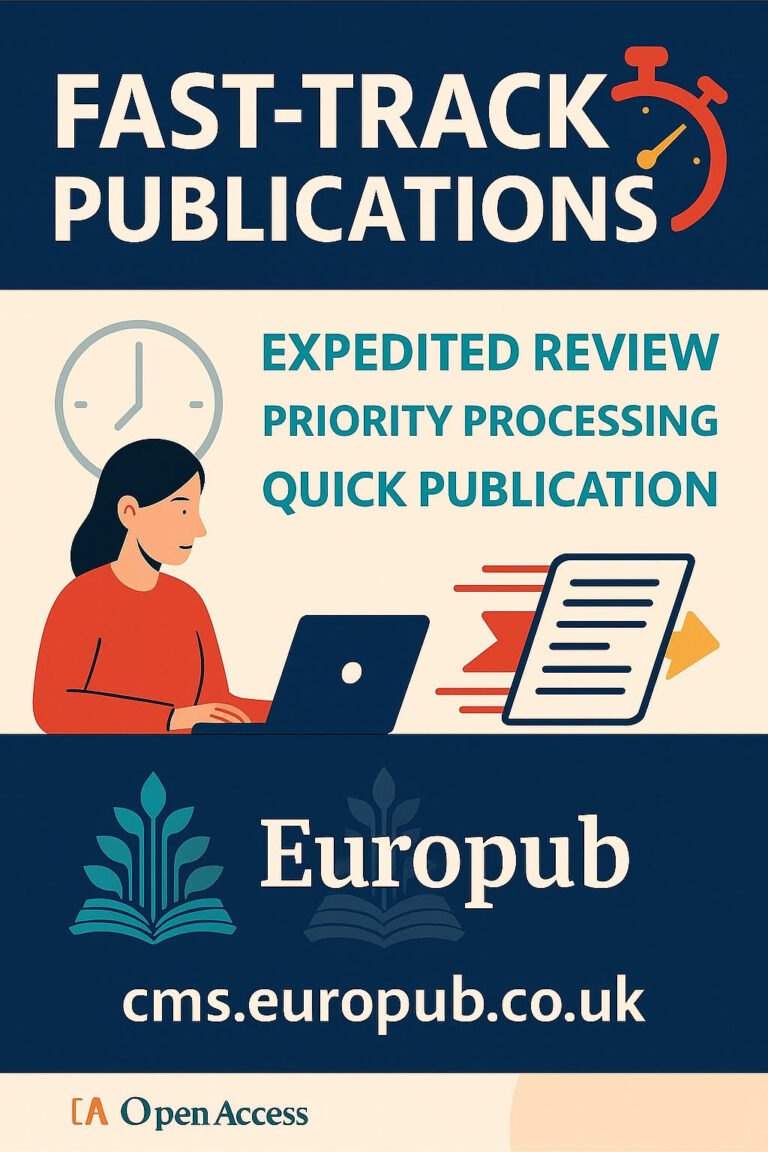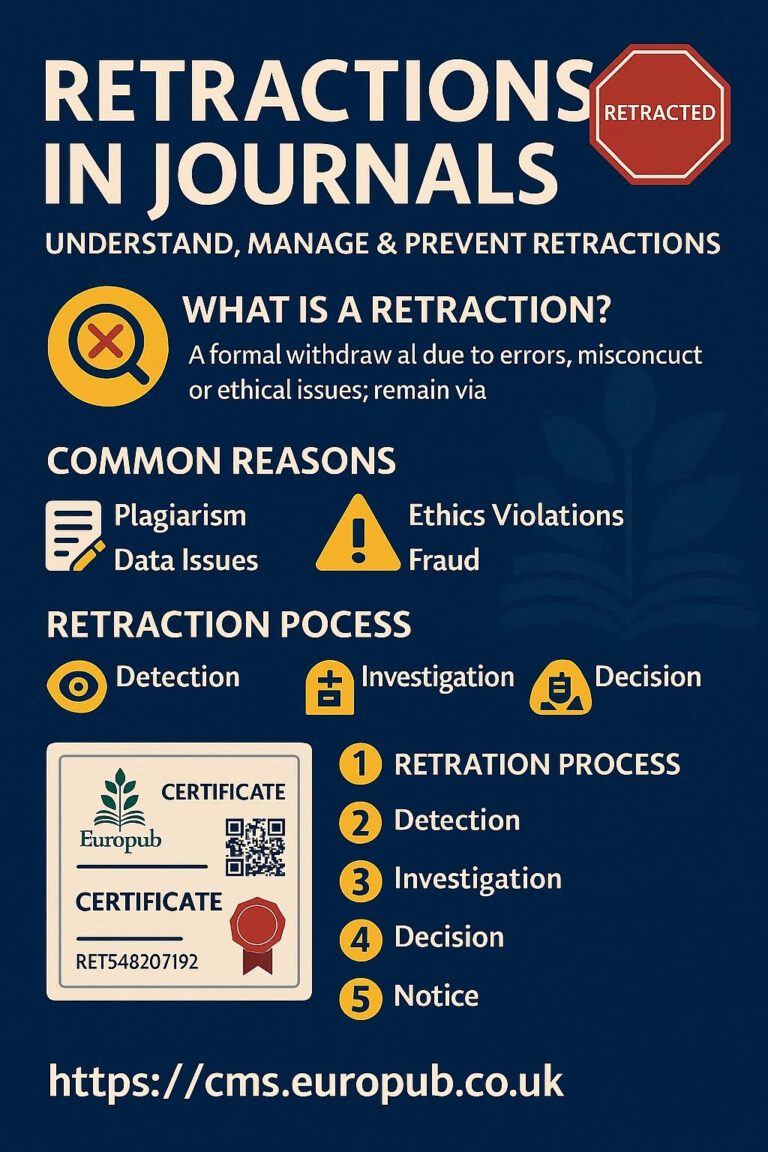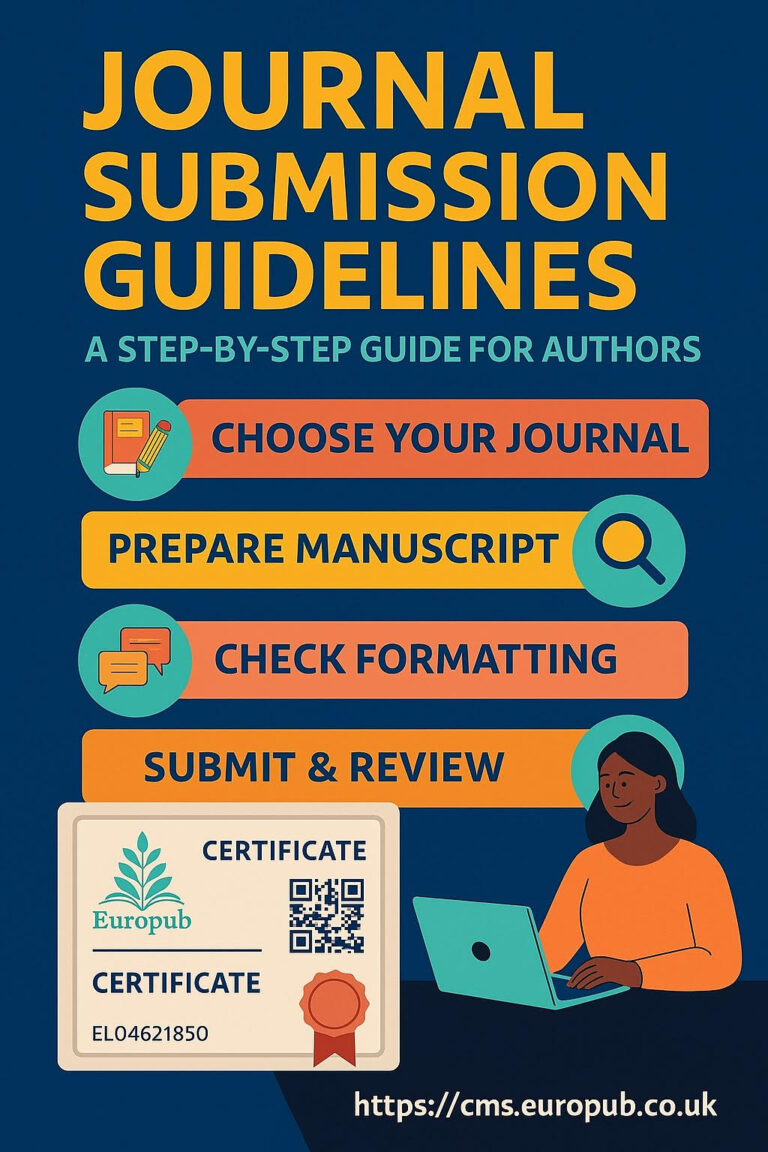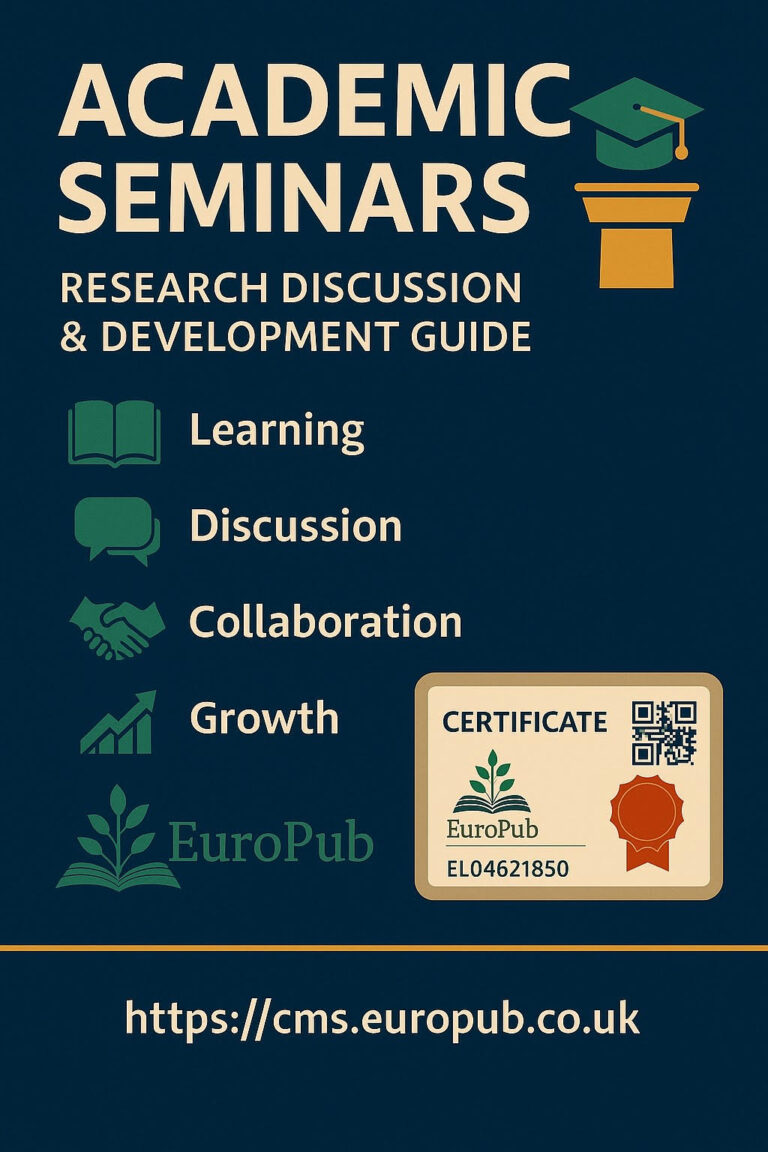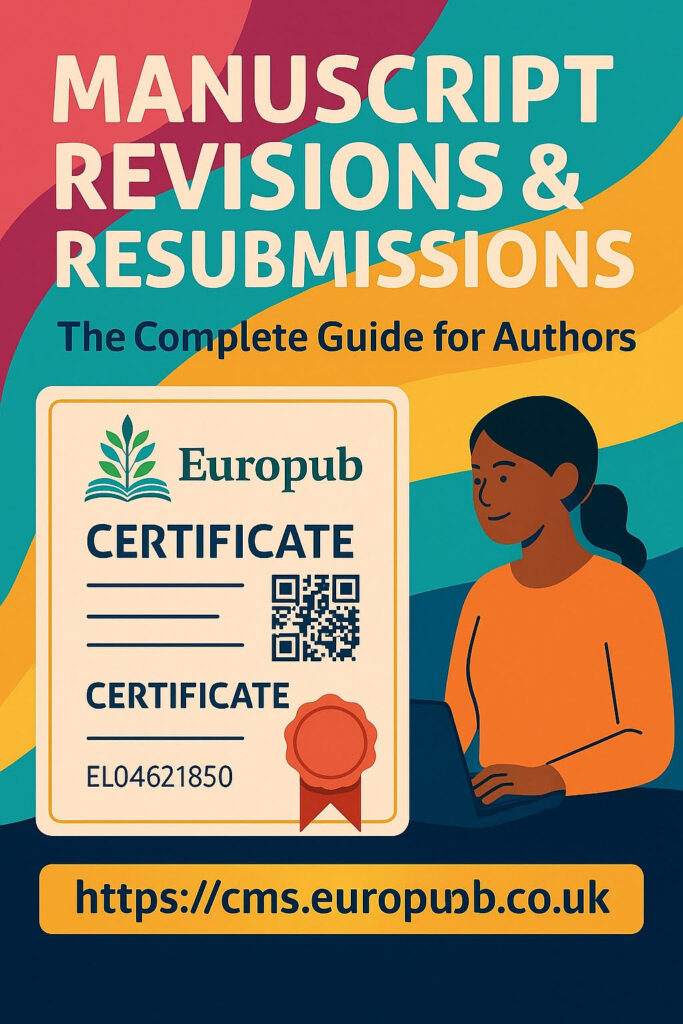
The Complete Guide for Authors (Prepared by
Europub Publishing Company Ltd. UK
Introduction
The revision and resubmission stage is one of the most important parts of academic publishing.
It’s where your paper evolves through peer feedback and editorial guidance before final acceptance.
Handling revisions professionally demonstrates scholarly integrity and increases your chances of publication in reputable journals indexed by Europub, Scopus, or Web of Science.
Understanding the Decision Types
After peer review, you’ll typically receive one of the following editorial decisions:
| Decision | What It Means | Action Required |
|---|---|---|
| Accept as is | Rare — paper is ready for publication | Minor formatting only |
| Minor Revision | Only small edits needed (clarity, grammar, figures) | 1–2 weeks |
| Major Revision | Substantial changes (methods, analysis, or data) | 2–6 weeks |
| Revise & Resubmit (R&R) | Must resubmit as new version; full re-evaluation | Treat as new submission |
| Reject (with option to resubmit) | Not suitable in current form | Rework fully before resubmission |
Core Principles of Revision
- Be professional and positive — reviewers are collaborators, not opponents.
- Address every comment clearly — no skipped or ignored feedback.
- Use the same tone as academic writing — precise and objective.
- Keep your original file + revised version for record and comparison.
- Submit your revision before the deadline — extensions must be requested early.
The “Response to Reviewers” File (Template)
Every revision must include a detailed response document.
Structure Example:
Reviewer Comment 1:
“The introduction lacks sufficient context for the study.”
Author Response:
We added two new paragraphs on page 2–3 citing Smith et al. (2023) and Lee (2022) to explain the historical framework.
Reviewer Comment 2:
“Statistical analysis should include post-hoc tests.”
Author Response:
We re-ran the ANOVA including Tukey post-hoc tests; results are now reported in Table 4 (page 9).
Formatting Tips:
- Use a table or color coding (e.g., reviewer comments in blue, author responses in black).
- Always thank reviewers for valuable feedback.
- Never argue emotionally — provide data and reasoning.
Checklist Before Resubmission
 Revised manuscript with tracked changes
Revised manuscript with tracked changes
 Clean version (without tracked changes)
Clean version (without tracked changes)
 Response-to-reviewers file
Response-to-reviewers file
 Updated figures and tables
Updated figures and tables
 Revised cover letter
Revised cover letter
 Proof of ethics approval (if needed)
Proof of ethics approval (if needed)
 Updated ORCID and author information
Updated ORCID and author information
 Compliance with journal formatting
Compliance with journal formatting
Cover Letter for Resubmission (Example)
Dear Editor-in-Chief,
We appreciate the constructive feedback from the reviewers.
We have carefully revised the manuscript entitled “[Paper Title]” according to all suggestions.
All changes are highlighted, and detailed responses are included in the attached “Response to Reviewers” document.
We hope this revised version now meets the standards of [Journal Name].
Sincerely,
[Author Name, Affiliation, ORCID]
Tips for Effective Revision
- Start with reviewer #1 and proceed sequentially.
- Avoid deleting data — justify if you omit something.
- Use precise academic language when defending your approach.
- Add extra citations or figures if reviewers requested clarity.
- Ensure the conclusion aligns with revised results.
Resubmission Process
- Login to your submission portal
 https://cms.europub.co.uk
https://cms.europub.co.uk - Upload the revised files (clean + tracked versions).
- Attach the response file and new cover letter.
- Confirm metadata (author names, affiliations, ORCID).
- Submit and verify receipt via email confirmation.
Post-Revision: What Happens Next
- Editorial Check (2–5 days): ensures changes address reviewer comments.
- Second Peer Review (if major revision): typically 2–4 weeks.
- Final Decision: accept / reject / further minor revision.
- Proof Stage: author checks layout, figures, and references.
- Certificate Issuance: automatic QR-based Europub certificate after publication.
 Request your certificate at https://cms.europub.co.uk
Request your certificate at https://cms.europub.co.uk
Revision Statistics (Best Practices)
| Stage | Average Duration | Tip |
|---|---|---|
| Minor revision | 7–14 days | Keep all edits transparent |
| Major revision | 3–6 weeks | Respond comprehensively |
| Second revision | 1–3 weeks | Maintain tone and coherence |
| Proof approval | 48–72 hours | Review all DOIs and figures |
Common Mistakes to Avoid
 Ignoring one or more reviewer comments
Ignoring one or more reviewer comments
 Uploading the wrong file version
Uploading the wrong file version
 Forgetting tracked changes
Forgetting tracked changes
 Changing co-authors without permission
Changing co-authors without permission
 Arguing emotionally in responses
Arguing emotionally in responses
 Submitting after the deadline
Submitting after the deadline
Extended FAQ (30+ Questions)
Q1. What does “revise and resubmit” mean?
It means your paper is promising but needs improvement before re-evaluation.
Q2. Can I disagree with reviewers?
Yes — politely. Provide logical explanations and supporting data.
Q3. Should I highlight all revisions?
Yes. Use “Track Changes” or color text (red or blue).
Q4. What if I need more time?
Request an extension before the deadline — most journals will grant it.
Q5. Can I change my paper’s title during revision?
Yes, if it better reflects content; note this in your response file.
Q6. Should I recheck grammar and formatting?
Always. Reviewers expect a polished submission.
Q7. What if one reviewer is clearly mistaken?
Address it respectfully and provide evidence; editors will judge fairly.
Q8. Can I add new data or figures?
Yes, if it strengthens your argument — label new sections clearly.
Q9. Should I cite reviewers’ work?
Only if it’s relevant and not coerced.
Q10. What is the role of the editor during revision?
They ensure reviewer feedback is properly addressed and maintain quality standards.
Q11. How to upload a revision on Europub CMS?
Login → Select “My Submissions” → Upload revised files → Confirm.
Q12. What happens if I don’t respond to all comments?
Your revision may be rejected or sent back.
Q13. Can I add co-authors?
Only with written consent of all existing authors and editor approval.
Q14. Is plagiarism checked again after revision?
Yes, most publishers rerun iThenticate on revised manuscripts.
Q15. What should I include in my response file?
Every reviewer comment with a corresponding author response.
Q16. Do reviewers see my tracked changes?
Usually yes — unless the journal removes markup automatically.
Q17. Can I attach supplementary materials?
Yes, if requested or if data clarification is needed.
Q18. Should I re-upload all files or only modified ones?
All files — old and new — to ensure completeness.
Q19. What is a “second-round revision”?
When reviewers request further clarification after major revision.
Q20. How long should I wait before asking about decision?
At least 4–6 weeks after resubmission.
Q21. Do all revisions require re-review?
No, minor ones often go straight to editorial decision.
Q22. What if my revision is rejected?
Learn from comments; resubmit elsewhere after improvement.
Q23. What are the benefits of careful revision?
Faster acceptance, better citations, and stronger publication record.
Q24. Can I use AI grammar tools during revision?
Yes, for clarity — but disclose in the cover letter if used extensively.
Q25. Is there a limit to the number of revisions?
Usually 2–3 rounds before a final decision.
Q26. How to ensure coherence after revisions?
Re-read the entire manuscript — not just changed parts.
Q27. Can reviewers see earlier versions?
Yes, editors retain full submission history.
Q28. Should I thank reviewers in my paper?
No, acknowledgment is not needed unless explicitly invited.
Q29. Can I appeal a rejection after revision?
Yes, through formal appeal with strong justification.
Q30. Do I get a new DOI after revision?
No, DOIs are assigned after acceptance, not for revisions.











